Hindle telescope
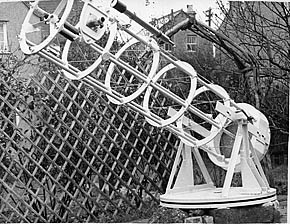
The Hindle telescope before it came to Keele (note the eyepiece at the primary focus). Larger image
This telescope is a 17-inch (43.3 cm) reflector, with a focal length of 74 inches (2.44 metres). It was made by Hindle (1869–1942) in 1939, probably for Mr Leslie Dilks of Manchester Astronomical Society. The primary mirror is plate glass. Dr Maddison purchased it for Keele in 1966. Prior to that, it was in the posession of Roy Worvill of Chipping Norton and (briefly) Father McKeon (Stoke area). It had an altazimuth mount, as seen below.
Once at Keele, Hindle's telescope was mounted on top of the 12-inch Grubb refractor, somewhat in the way the original Cartes du Ciel astrograph would have been mounted in the 19th century. However, the Hindle was very massive, the open tube having been made in steel (Hindle was originally an engineer by trade). In order to reduce the mass, a new fibreglass mirror cell was made, but the whole telescope had to be carefully rebalanced. The telescope (as seen above) had been designed to be used at Newtonian focus, but a hyperbolic secondary was made by Jim Hysom, so that the telescope could be used at the Cassegrain-Newtonian focus (sometimes called a modified Cassegrain). Dr Maddison later drilled out a hole in the primary mirror, so that it could also be used at Cassegrain focus.
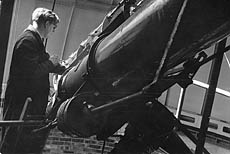
|
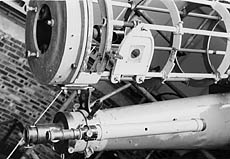
|
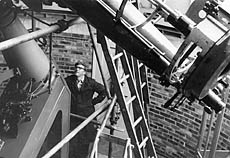
|
|
Dr Maddison carrying out final adjustments |
The Hindle telescope mounted on the Grubb refractor; note the reused plate from the original primary focus. Larger image
|
Dr Maddison, amidst the scaffolding and ladders. Larger Image |
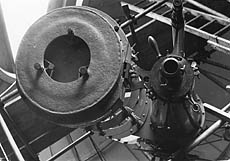
|
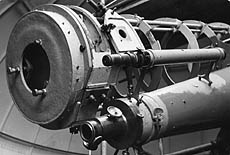
|
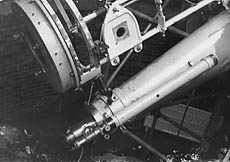
|
| The back end of the two telescopes, showing the new glass fibre cell. Larger image |
The Hindle and Grubb telescopes, with the smaller Grubb finder telescope. Larger image | The new Cassegrain-Newtonian focus. Larger image |
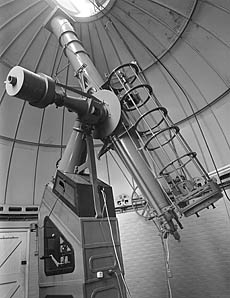
|
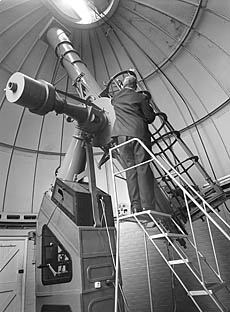
|
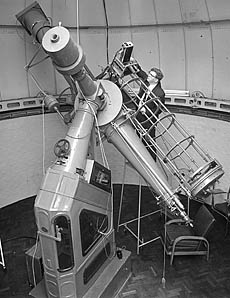
|
| A wide-angle shot of the pair of telescopes circa 1967. Larger image |
Using the Hindle at prime focus. This illustrates one problem with the telescope: its primary focus was rather inacessible. Larger image | Using a vidicon (an early electronic camera) in the 1970s. The image was broadcast to other campus locations. Larger image |
The Hindle has not changed much since the 1970s. It has rarely been used, as the drive (being old) isn't good enough for long-exposure imaging. In the 1990s, it was used to take a small number of photograps at primary focus. In 2006, it was used with a sensitive video imager as an experiment; five of Saturn's moons could be seen in real time. As the 1939 optics would not be suitable for imaging using modern CCDs (charge-coupled devices), this telescope should now be considered just a historic instrument. Three recent (2004) photographs of the Hindle and Grubb telescopes are shown below:
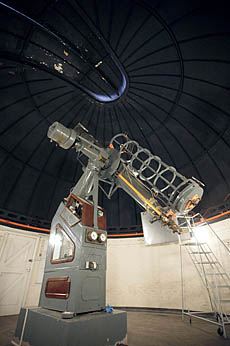
|
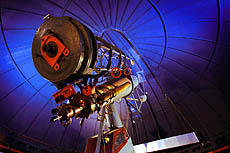
|
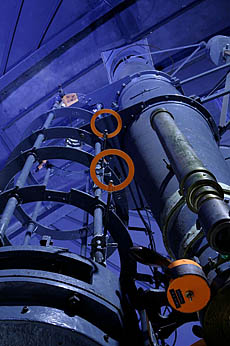
|
| The Hindle on top of the Grubb refractor (the supporting pillar is vertical of course; its appearance here is a lens effect). Larger image | In this picture (with a blue floodlight) the Cassegrain focus of the Hindle can be seen. Larger image | This picture gives a good idea of the relative sizes of the two telescopes. Larger image |

